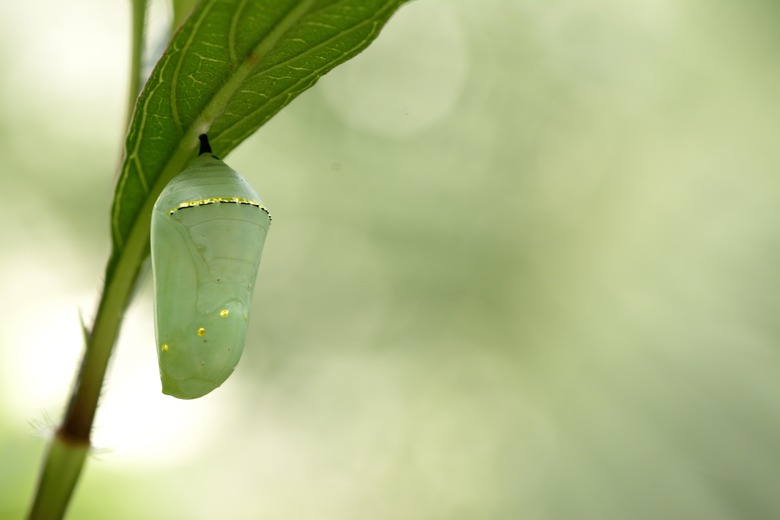How To Identify Caterpillar Cocoons
Caterpillar cocoons are a pupal metamorphis stage that butterflies undergo before reaching their adult stage. During this time, they radically transform, evolving from a caterpillar to a butterfly. Most caterpillars spin their cocoons from tree branches, while others create them in areas where they know they are not going to be disturbed, such as the roof of a home or in thick brush or bushes. Cocoons often have unique features that make it possible to identify the creature inside.
Step 1
Identify the covering of the cocoon. Most moths and butterflies come from pupa that hang from tree branches as silk padding. These cocoons are typically white or translucent, depending on what stage of metamorphosis the caterpillar is currently in.
Step 2
Identify the color of the cocoon. Most cocoons, regardless of the species inside, begin as a white color and eventually become brown. Other cocoons may turn green. Butterfly cocoons typically have a pupa that begins as white and becomes translucent green over time, while other insects, like beetles, have brown cocoons, or cocoons that remain white during the entire transformation phase.
Step 3
Examine the cocoon's actual shape for clues as to what type of insect is transforming inside it. Most moth and butterfly cocoons are an oval shape, and they have a natural structure that begins smaller on one end and then gradually grows in size until reaching the other end. The side that is the smallest on the cocoon is the side that hangs from the branch. Other insects create unique cocoons that vary in size and shape depending on the species of the insect.
Step 4
Examine the nearby area to see if there are any adult insects of the same species nearby. Butterfly and moth cocoons are typically guarded and protected by ants, so locating ants nearby is an indication that the insect inside is a moth or butterfly. Other insects that utilize cocoons for their transformation are typically guarded by adults of the same species.
Step 5
Take note of whether there is a shell covering. Only a few insects actually use a shell covering that they can protect themselves with during the pupa stage, and moths are one of these species. The shell is designed to break open eventually. Butterflies, on the other hand, do not utilize a hard shell coating; their cocoons are soft and silky.
References
Cite This Article
MLA
Uhl, Jennifer. "How To Identify Caterpillar Cocoons" sciencing.com, https://www.sciencing.com/identify-caterpillar-cocoons-5937515/. 19 April 2018.
APA
Uhl, Jennifer. (2018, April 19). How To Identify Caterpillar Cocoons. sciencing.com. Retrieved from https://www.sciencing.com/identify-caterpillar-cocoons-5937515/
Chicago
Uhl, Jennifer. How To Identify Caterpillar Cocoons last modified March 24, 2022. https://www.sciencing.com/identify-caterpillar-cocoons-5937515/
